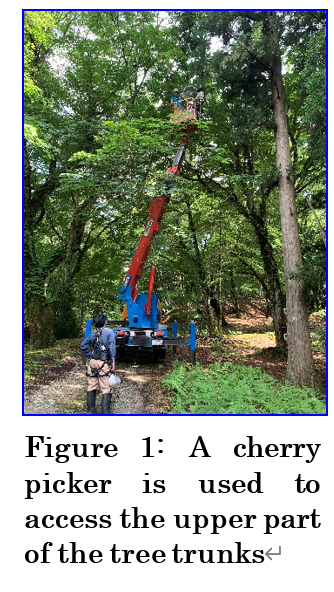研究課題
樹木内におけるメタンの生成と拡散のメカニズム:メタン生成源の幹内空間分布
Production and diffusion of methane in trees: spatial distribution of CH4 sources inside the trunks
研究組織
| 代表者 | EPRON Daniel, Kyoto University, Graduate School of Agriculture |
|---|---|
| 共同研究者 | TAKAHASHI Kenshi, Kyoto University, RISH MOCHIDOME Takumi, Kyoto University, Graduate School of Agriculture ASAKAWA Susumu, Nagoya University, Graduate School of Bioagricultural |
| 関連ミッション |
|
研究概要
Methane (CH4) is the second most important anthropogenic greenhouse gas and rise of atmospheric CH4 concentration has accelerated these last years. In addition to global warming, CH4 oxidation in the troposphere leads to ozone production, which is harmful to human health and crop yields. Forests are a well-known carbon sinks, which mitigate the rise in atmospheric CO2 and hence global warming. Soils in upland forests are the largest biological sink for atmospheric CH4, providing a valuable ecosystem service. However, trees emit CH4 and it is necessary to consider the role of the trees in addition to that of the soil to establish a complete methane balance of a forest ecosystem. Mountain forests cover nearly two-thirds of Japan land area, but we still know little about the role of trees in their CH4 budget.
The trunks of several tree species in the Ashiu experimental forest harbour methanogenic archaea, produce CH4 internally and emit it to the atmosphere. Differences in gas diffusivity between the radial and the axial direction in the wood can result in the complex vertical pattern of stem CH4 emissions that we have observed last year by measuring CH4 flux at a height of up to 12 m. Physical modeling of CH4 transport in tree trunk has not yet been attempted but an existing model developed for CO2 transport [Holtta and Kolari, Tree Physiol. 2009] can be adapted if we are able to locate the source of CH4 within the trunks, which are radically different from those of CO2. Our goal is therefore to characterize the vertical profile of tree CH4 production within the trunk by measuring the potential of methane production, the internal CH4 concentration and the methanogenic archaeal communities in the wood at different height all along the trunk using a cherry picker to access the top of the trees.

- We will use a cherry picker to access the upper part of the trunks of the trees on which we have already measured stem CH4 emissions up to 12 m in height last year, and which are lining the forest dirt roads in our working area.
- We will first measure CH4 emissions along the trunk every 1 m until 12 m and immediately afterward, we will take a wood core down to the pith using an increment borer.
- A 10 cm long stainless tube will be inserted in each hole resulting from the coring and plugged with a rubber septum. After three days, gas will be drawn from inside the hole through the septum into a syringe and injected through the septum our CH4 analyzer.
- Two segments, representing the inner heartwood and the outer sapwood, will be cut from all the wood cores extracted from the trunks, sealed in glass vials which will immediately be flushed with an incubation mixture (10% CO2 and 1% H2 in N2). The potential CH4 production capacity will be estimated by drawing gas at regular intervals from each vial through their septum into a syringe and injecting the sampled gas through the septum our CH4 analyzer.
- After the completion of the incubation, all segments will be stored at -30°C and transferred to Nagoya University. The segments will be minced, and DNA will be extracted and purified before performing PCR amplification to estimate copy numbers of mcrA genes of methanogenic archaea.
Mochidome T will visit Teemu Holtta at the University of Helsinki (Finland) with the results obtained last year and this year to receive research guidance on modelling gas transport in tree trunks using diffusion equations in cylindrical coordinates. We expect the model can be used to scale trunk CH4 emission to whole trees and forest, to be compared to the spatially averaged soil CH4 flux that we are also measuring.
ページ先頭へもどる
2023年8月8日作成


